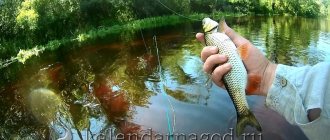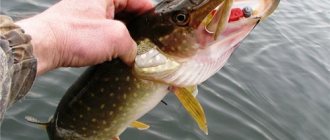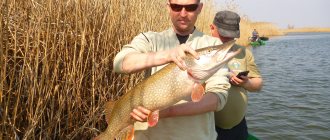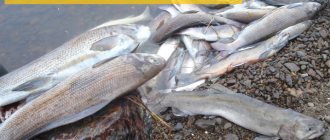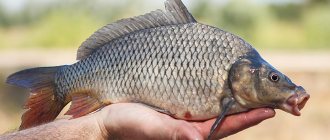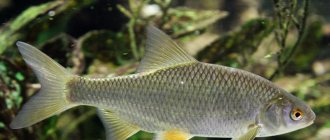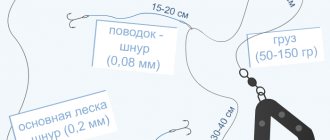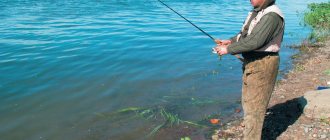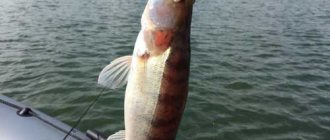Every angler dreams of learning how to catch pike. This skill requires practice, as well as knowledge of fish behavior and habitats.
It’s not for nothing that pike is hunted so fiercely; its meat is considered dietary and rich in vitamins. Young individuals have a special taste. The pike bite very often depends on many factors, which is why you should study all the nuances.
Features of pike behavior and habitat
Fish lives in rivers and reservoirs. Being a predator, she prefers secluded places, for example, reeds, grass, and snags. Prefers places with reverse currents and whirlpools.
Adults, large individuals more often spend time in pits. Inhabitants of closed reservoirs mainly swim behind schools of fish, eating them from time to time. Such pikes are lazier than river pikes.
During spawning, individuals try to swim into shallow water. After spawning, pike need about a week to regain their strength.
In summer, pike are found in shady and cool places. In hot weather, it is better to choose a place for fishing where you stand with your back to the sun. As the air temperature drops, the pike goes deeper, hiding in holes.
These fish are very sensitive to touch. That is why their behavior can be very strange; pike can jump out of the water and change movements, which often confuses an inexperienced fisherman.
Note! Catching pike is not as easy as it seems. The predator is prudent; the holes in which it hides usually have only one exit. The fish always positions its head towards it, which allows it to avoid being attacked from behind. The method of movement is usually chosen against the current, using quick jerks through the water.
What is a biting calendar?
The number of factors influencing the biting activity of pike is not that many, as in comparison with other types of fish, but not small either.
What is taken into account when compiling a fishing calendar and why these factors have an impact:
- Ambient and water temperature. Considering the fact that fish directly respond to changes in water temperature and the environment, since this affects life processes, because fish are cold-blooded creatures, warming or cooling is closely related to biting activity.
A gradual increase in the temperature of reservoirs has a beneficial effect on the stability of pike biting. A sharp drop in water temperature leads to the fact that many subspecies of fish are passive about going out hunting; this rule also applies to pike. - Changes in atmospheric pressure. The changes that occur in the atmosphere also affect the stability of the bite; it is this factor that is among the leaders when compiling pike biting calendars. Everything is explained very simply - the aquatic environment in which pike lives has a density, which affects the amount of oxygen.
Moving in the water, the fish has its own barometer in the form of a fish bladder, and it is this that gives signals to the fish about an increase or decrease in atmospheric pressure. It is enough to look at your home barometer and its readings to draw the appropriate conclusions for yourself.
The optimal pressure option: when the barometer needle is in the sector between “cloudy” and “clear”, without sudden changes. A decrease in pressure and a sharp cold snap are not the best weather factors for catching pike; it, like other subspecies of fish, loses activity and goes to depth.
- The rise and fall of water levels in reservoirs. If the rise in water level in reservoirs is not sharp, as well as the decline, this is poorly reflected in the pike bite, the fish is simply further away, or closer from the shore when hunting, why this happens is simply explained - the prey is also looking for places to feed, and they Along with changes in height, the banks can change. In dry weather with a long period of heat, water bodies partially dry up, the oxygen level in such conditions can drop to critical limits, at these moments almost all types of fish reduce their biting activity, and pike do not hunt at all during the day.
- Precipitation. Pike is indifferent to snow or other precipitation, the main thing is that it is uniform rain or snow without strong gusts of wind. On the contrary, during warm, quiet rain, when the surface of the reservoir is covered with light ripples, the pike comes out to hunt from the depths to lighter areas of the bottom - the absence of bright sunlight camouflages the predator in its habitat from the prey as much as possible.
- Water color. Knowing the characteristics of the periods of the year when the water changes the color of the water from blooming algae and becomes greenish-dirty, experienced fishermen, using the pike biting calendar, rarely use piece bait. During this period, the predator prefers to attack fry and small fish near the bottom at a distance of 25–50 cm from the ground. Fishermen often use a variety of bottom-type fishing gear: set-ups, girders, bottom hooks.
- Moon calendar. As strange as it may sound, the presence of the moon in different phases is directly related to pike biting. This has been scientifically proven and does not require proof of confirmation of the fact; when compiling bite calendars, fishermen are guided by these data.
When the pike comes - biting calendar by season
Spring
- The first warmth forces the pike to go up from the depths in search of food. The first half of March is the most suitable time for pike fishing. At this time, the fish are especially hungry, so they very actively attack many baits. When choosing a place for fishing, you should pay attention to a clean area with a lot of grass.
- The next suitable period is early April. At this time, the pike is preparing for spawning. The end of April is characterized by muddy water, so it is very difficult to find prey. At this time, it is preferable to use noise baits.
- In May, after spawning, pikes again have an excellent appetite, so this time should be taken into account. In May, small individuals usually bite, since large fish are inactive due to the change of teeth. The most suitable place for fishing is the thickets. It is best to fish with active wobblers, spinners and live bait.
It should be remembered that the ban on spinning fishing begins in May.
Summer
The fish survives the hottest days at depth.
That is why fishing should be carried out on cooler days and choose the appropriate place:
- Pits and springs.
- Places with thickets.
- Shady places.
The best time of day for fishing is 4-7 am. At this time it is not hot, the fish are hungry and active.
In June it is already allowed to fish with spinning rods. This month, the fish go into the grass thickets, where there is a large amount of food for pike.
June is the month when the pike accumulates mass and, accordingly, does not miss the bait.
In July, the peak of the heat begins, because of this, large individuals go to the depths and hunt little. Small specimens are active, as they require weight gain.
Let's celebrate! In August, the air temperature drops, and accordingly the fish become more active. You can catch a predator anywhere using different baits.
Autumn
Ideal time for fishing. At this time it is no longer hot, but there is no frost either. The autumn feeding period of pike is the most active and long-lasting. Very often you can catch a large specimen.
- In September it is best to use large and noisy baits. For a better bite, you can go fishing from a boat.
- October is the best period for spinning. At this time, the pike accumulates mass and actively bites. The recommended baits are: spinner, jig, large wobblers. Lures that are shiny and move are the best. You should not fish with live bait at this time.
- In November there is a chance to catch an especially large specimen. To do this, you should choose the optimal weather, rainy and windy weather. The best baits are spoon spoons and vibrotails.
Let's celebrate! Bait made from dead fish will be an excellent solution, since at this time pikes feed on carrion from the bottom of reservoirs. The most suitable time is early in the morning or before sunset.
Winter
In December, with the appearance of the first ice, there is an opportunity to hunt for pike well. At this time, the fish tries to stay in shallow water in search of food. It should be remembered that this fish is very sensitive to any rustling noises. When the ice becomes strong, fishing is more productive.
In January, the predator is especially passive, this is due to frosts. The only option is to come fishing on a warm day when it is light outside. Gears and baits are used as bait.
Note! In the second half of February, the pike feels the arrival of heat and begins to be active. That is why fishing is especially good during this period. The best baits: spoon, balancer and live bait.
How to catch pike?
There are many ways to catch pike.
Some of them have been used since time immemorial, others have come into use quite recently.
Zherlitsy
This is the simplest and not at all sporty way. There is no fight against a predator, but there is a simple everyday calculation. Using it, the fisherman attaches to a tree at night (in shallow water to a pole stuck in the sand) a wooden flyer with a fishing line wound around it.
The fishing line is fixed in a split at the end of the flyer, a sinker is hung from it, and live bait is attached to the hook. It is important to choose the right place to install the trap. It is most often placed over a pool or over a place where there are bottom anomalies - that is, a potential refuge for a predator.
At night, attracted by the fluttering of the bait, the pike leaves its ambush and gets hooked, after which you can safely cook fish soup from it.
Mugs
This is also a very old way. With it, the fisherman uses foam or carved wooden circles wrapped with 10 meters of fishing line. Using a specially planed stick, the fishing line is attached to the part of the circle that is above the water.
To its other end, on the hook, a sinker and live bait are attached. With this bait, the fisherman has to stay nearby. As soon as the pike catches on it and pulls, the fishing line will begin to unwind, the pike will be firmly planted on the hook, and all that remains is to pull it out of the water.
The advantage is that the circles themselves look for prey - the live bait attached to the circle behaves as naturally as possible and simply pulls the circle along with it where instinct tells it.
Pike fishing rod
This is an ordinary small float fishing rod, which is equipped with guide rings and a reel.
A live bait is attached to it, and a champagne cork is used as a float so that the live bait cannot drown it on its own. It is also important to pay attention to the leash - it must be made of material that is resistant to sharp pike teeth, otherwise the predator will simply tear it off and swim away with the hook.
You can use special wiring - metal, invisible - or you can limit yourself to a thin fishing line folded in half.
Pike fishing rods are good in small rivers overgrown with reeds and reeds, as well as on overgrown lakes, where you have to cast into clean windows between water lilies and algae. They fish with it using the walking method - moving along the shore of the reservoir, they estimate by eye where the prey might be, and cast the fishing rod.
If there was no bite for half an hour, despite the fact that the bait was swimming freely and should have attracted a predator, the place should be changed - there is no one in the chosen place.
What factors influence pike bite?
The nature of pike biting is influenced by a certain number of factors:
- Moon phase. The activity of any fish directly depends on what phase the moon is in at the time of fishing. There are two most suitable periods for pike fishing: the first 7 lunar days, as well as from 17 to 21. The moon has the greatest influence on the activity of fish that live in closed reservoirs.
- Weather. The best weather conditions for pike hunting are cloudy and cool. The presence of rain also has a positive effect on the bite. A drop in atmospheric pressure also affects fishing. Before a thunderstorm, fish activity increases. A sharp drop in temperature, for example in winter, reduces the possibility of biting. The more stable the weather, the greater the likelihood of successful fishing.
- Times of Day. The activity of pike during the day can vary. On average, the pike exit lasts for 20 minutes. The best time is considered to be before dawn, as well as 10-12 noon. A good bite is also observed after 3 o'clock in the afternoon in the dark.
The right time to hunt pike
You should engage in quiet hunting, chasing pike, 2 times a year:
- In the spring, when this fish is too hungry.
- In mid-autumn, when there is every chance of hooking a large, fleshy specimen.
The answer to the question: “When is the best time to catch pike?” very simple. The first period is spring, when females weaken after spawning and grab any bait without thinking. This season of fishing for pike with a spinning rod is called the “post-spawning glutton of the predator.”
With the arrival of summer, the activity of pikes is noticeably lower, and it is almost impossible to lure them to the water. She hides in cool and secluded places.
But most of all, fishermen using spinning rods ask the question: “When to catch pike in the autumn?” This question “comes” to mind not by chance, because it is at this time that there is a high probability of catching a large and fleshy specimen on a hook. Fishing can begin in September. The peak of fish activity begins in the next two months and this rather long period continues until a decent crust of ice forms on the reservoir.
The ideal conditions for pike to bite are cloudy weather without thunderstorms or strong winds. The favorite habitat of such a predator is water bodies and coastal areas. They try to hide in secluded thickets. They especially like to stay in places where there are reeds and algae. On average, pike reaches a body length of 1.5 meters and a weight of 8 kg. Having caught a fish weighing more than 10 kg, you can consider yourself a successful fisherman. In some reservoirs there are specimens that weigh up to 30 kg.
On stormy and cool days without rain, the chances of catching the desired victim increase significantly. Try to choose the time to go on a hike, taking into account the weather conditions and the place where the predator is supposed to live.
Necessary conditions for pike fishing
- The correct time of day. As mentioned earlier, the best time to go fishing is early in the morning and in the afternoon.
- Weather. Lack of heat, coolness, little rain and wind are the best times to hunt for predators.
- Reduced atmospheric pressure.
- Temperature. In spring and autumn, the optimal water temperature is 8-25 degrees, and in winter the air temperature should not fall below 15 degrees.
- The right fishing spot. The presence of a large amount of grass and snags is optimal for fishing. Preference should be given to dams and riffles. It should be remembered that the largest individuals hide in deep waters.
Ideal atmospheric pressure for pike fishing
If we are talking about ideal pressure, then this is a stable low pressure that lasts for several days. But such pressure is typical for autumn, but in summer it is rare. Having gone fishing at low pressure, the angler is not immune from pressure surges during fishing.
Therefore, they often talk about optimal pressure, and the norm is 760 mmHg. Although the norm may be different for different regions, for example, in Siberia the normal atmospheric pressure is lower.
Lures and bait for pike fishing
Experienced fishermen recommend using various types of spoons in summer. You should not buy bright and flashy baits; it is better to buy a dark-colored spinner. Since pike may not be particularly active in summer, it is better to select bait at the fishing spot.
It is not advisable to use a popper, although it attracts with sound, but only because of this the fish will not rise from the depths. You can catch a pike with a popper only if it swims nearby.
In the autumn, spinners, wobblers and twisters are often used. It is best to choose large baits.
For winter fishing, it is best to choose balancers, spoons and live bait. When choosing moving lures, those with horizontal movement are best.
In spring, it is preferable to choose balancers, spoons, wobblers, and also add living creatures, such as a worm, to the bait.
Spinning fishing
Fishing with live bait is considered inhumane - there is no sports excitement, no element of fighting fish, only time-tested techniques.
Spinning is pleasure, excitement and struggle. It requires knowledge of the predator’s habits, fishing methods, and bait. There are several options:
- Jig. This is fishing with silicone baits, the hooks of which are equipped with a lead head. You need a braided fishing line so that the prey does not bite it, a complex rod and a medium reel.
- Twitching. This is fishing with treacherous wobblers using the jerk method. A rigid rod and non-stretchable fishing line are used.
- Jerking. This is fishing with large bladeless wobblers - jerks - using powerful rods and reels. With such equipment you can compete with a real river dragon.
- Trolling. Fishing from a boat equipped with an electric motor. The wobblers are large, deep-sinking, and are pulled behind it on a fishing line. You need a powerful rod, because the fish you come across are usually quite big.
Fishing with a spinning rod means animating the bait so that it seems like a living fish. This means fighting the pike in its field. This means experiencing the true passion of sports.
Reviews from fishermen
I got used to catching pike with a jig. Basically I prefer to choose places with abundant vegetation. The main thing is to choose the right size and weight of the jig head. The first attempts at catching pikes did not end in success, so I changed fishing spots very often until I found a suitable one. I would like to give advice to fishermen not to give up trying after unsuccessful attempts, you just need to be careful and everything will work out.
Grade:
Vladimir. 35 years
I have been fishing for many years, so I have some secrets of catching pike. It is important to choose suitable clothing so as not to greatly advertise your presence on the pond. Fishing should take place in as quiet conditions as possible so that the fish are not scared. The behavior of pike is sometimes unpredictable, so you should practice using a spinning rod. Grade:
Ivan. 42 years
I go pike fishing in the summer. In the area where I live there are few places for pike, so I choose reservoirs with a lot of algae. In my fishing area the depth is no more than 5 meters. I’m used to fishing with a spoon, but sometimes it gets stuck in the algae. That is why I recommend that beginners use other baits, so as not to have to suffer every time getting the spoon out. Grade:
Dmitry 30 years old
My favorite way to catch pike is using a wobbler. It has a small game, so in order to attract pike you need to constantly twitch it. I consider the most successful catch to be a pike weighing 9 kg. The advantage of a wobbler is that you can catch pike with it at any time of the year. Grade:
Andrey 43 years old
I approach pike fishing very responsibly. I take all the baits with me at once: iron, soft, wobblers, poppers. When I arrive at a place, I start fishing first with soft baits, then I switch to iron and wobblers. If you don’t catch fish, then you should look for another place and start over. Grade:
Artem 45 years old
Before hunting pike, you should carefully prepare. You need to know where it bites, suitable baits, and also what time of year and day it is advisable to go fishing. Proper preparation allows you not only to get positive emotions from the process, but also to please yourself with a successful catch.
Pike fishing calendar by month of the year
If you make a short calendar of pike fishing by month, you can describe the behavior and bite of this predator as follows:
January. Deaf winter. Pike is passive and is best caught using girders from under the ice.
Anyone who knows how to catch a decent pike on a girder even in January.
February. End of winter. Pike are starting to be caught using spoons and balancers, although the main catches still happen with live bait.
March. The last ice, the reservoirs are opening up. Pike are actively caught from under the ice using balance beams and spoons.
April. Fishing for pike in open water. You can catch it well with jigs and heavy spoons.
May. The beginning of the spinning ban. You can catch pike on a float from the shore.
June. End of the spinning ban. You can go out on the water and catch pike with all the baits. Wobblers and spinners work great in the water column.
July. Grass grows on ponds. Active pike fishing begins with surface baits - walkers, poppers, gliders, propbaits.
Summer is the best time to catch pike with wobblers.
August. Most of the ponds are in the grass. The best results are shown by catching pike with a Croatian egg.
September. The beginning of the autumn spinning season. As the water gets colder, the pike bite becomes more active. The predator is caught by trolling and jig, as well as using all baits in the water column.
October. The best month for catching pike by trolling and jigging. Pike actively feeds and is caught in the bottom layer using large baits.
November. The largest specimens of the year are caught with a heavy jig from the deepest places. In some regions the first ice has appeared. There, active pike fishing begins with spoons and balance beams.
Somewhere there is already ice on the reservoirs, but you can catch trophies with jigs in November.
December. Pike fishing on the first ice using spoons and balance beams is gradually giving way to girder fishing. Pike bites well on live bait.
To successfully catch a predator in a pond in each of these months, read special materials on our website that tell you how to organize pike fishing in a specific calendar month.
Just don’t forget that in the north of our huge country there is still ice, and in the south it’s already +20C and the apple trees have been blooming for a long time. Therefore, adjust for the weather in your region.
More on this topic on our website:
- Fishing for pike with a spinning rod in August - where, what and how Summer is coming to an end. Maybe this is not so noticeable in the city, but outside the city the foliage is already darkening with might and main, the first ones are appearing...
- The most catchy bait for pike depending on the fishing location. Remember this popular rhyme “Every hunter wants to know...” and so on? For a fisherman it will sound like “every fisherman wants...
- Fishing for pike in March with spinning rods from the shore and boat In response to the bright sunny days in early March, spinners take their gear out of storage and go to the reservoirs. Catching…
- What to do if the pike doesn’t bite - time and place When going to a pond, every angler, be it a floater or a spinning angler, hopes for a decent fish bite. Arriving at the reservoir and appreciating...
